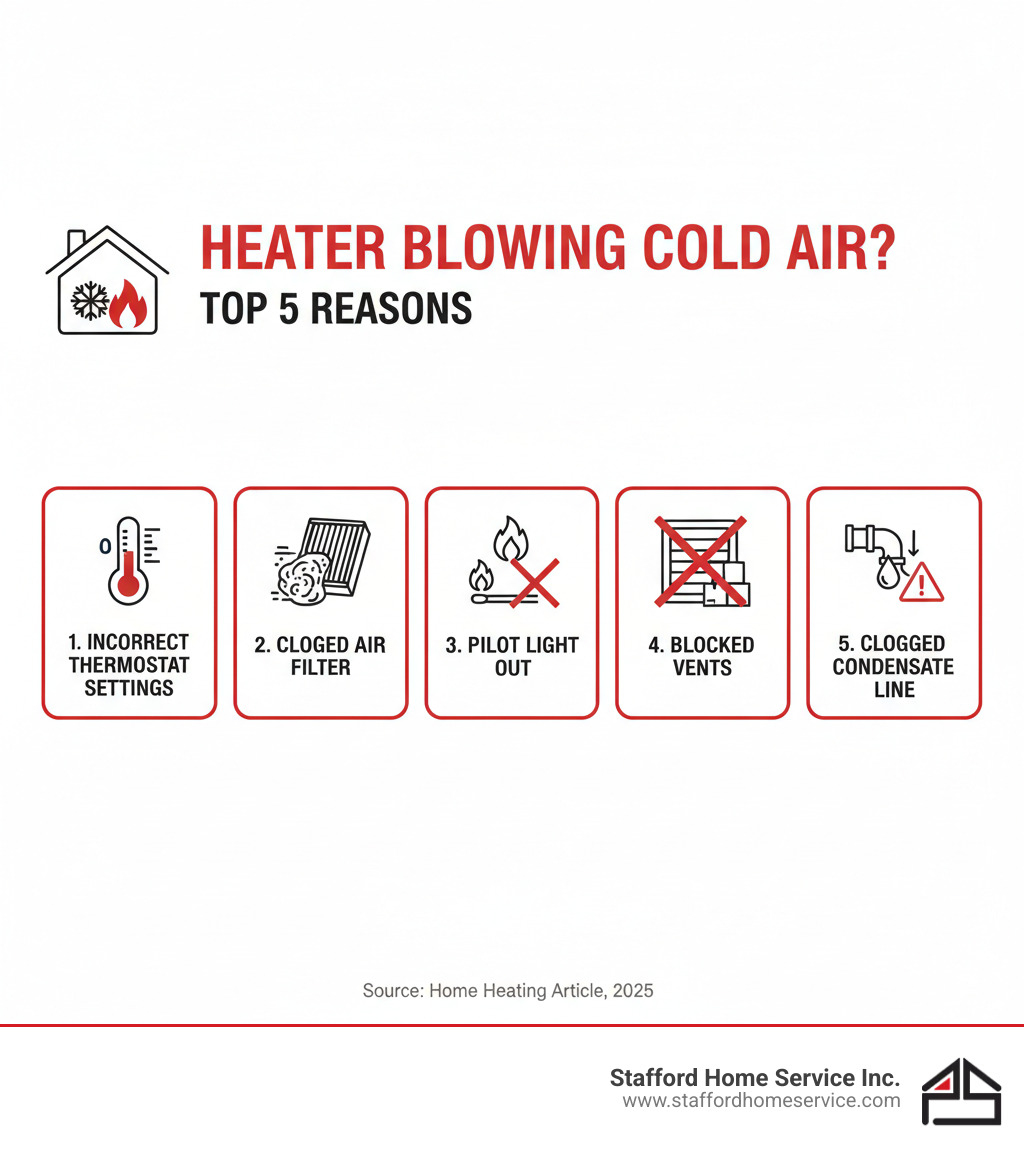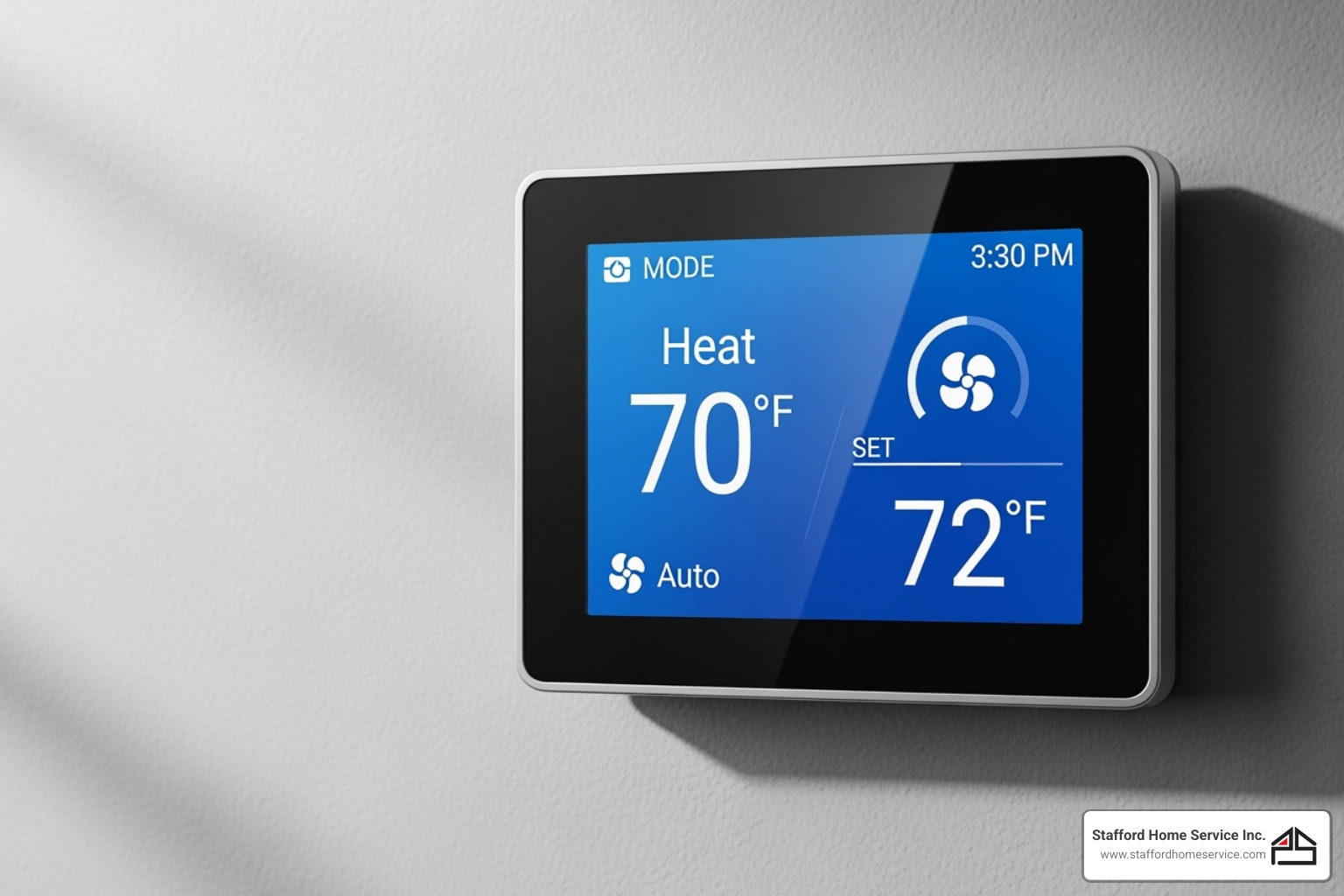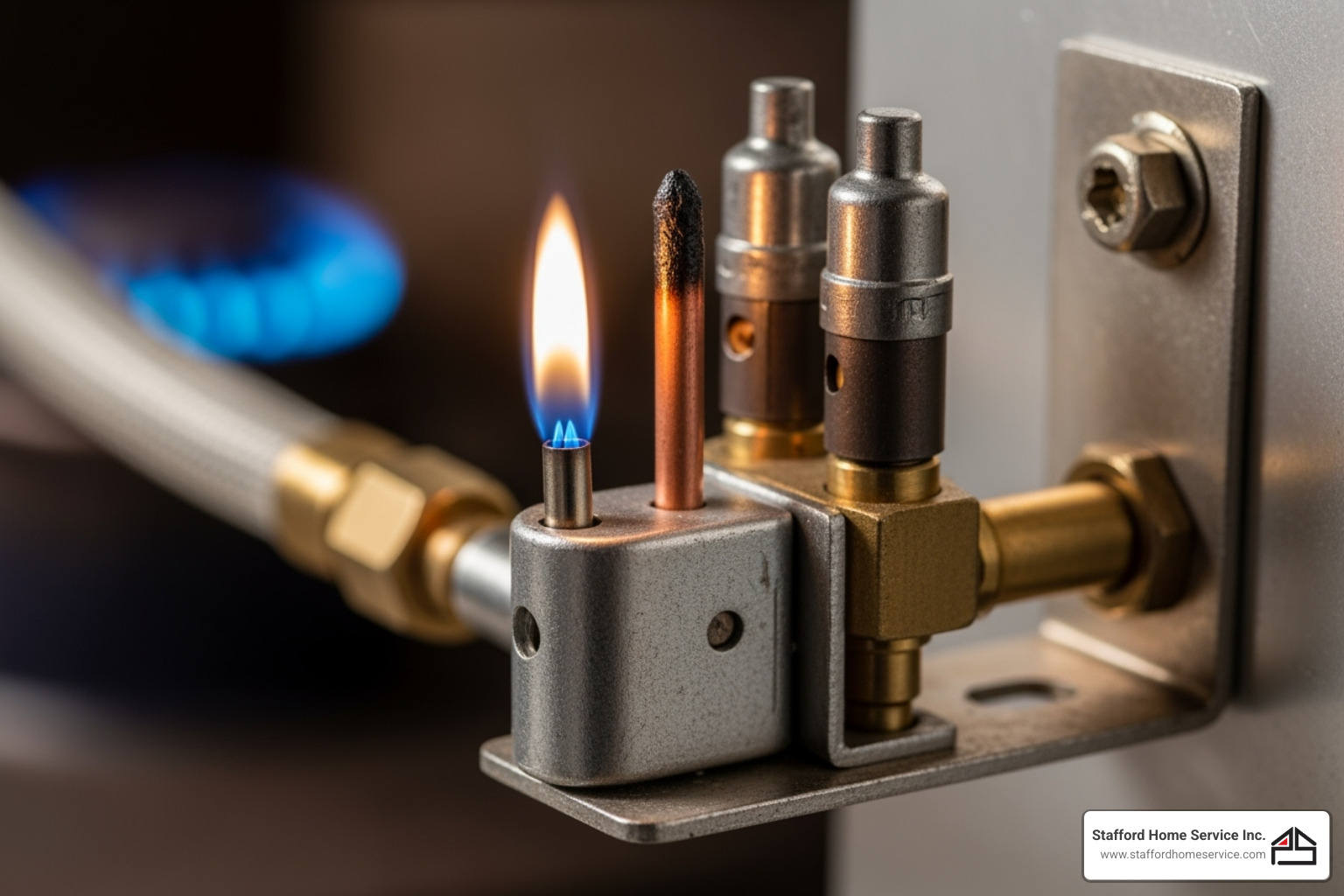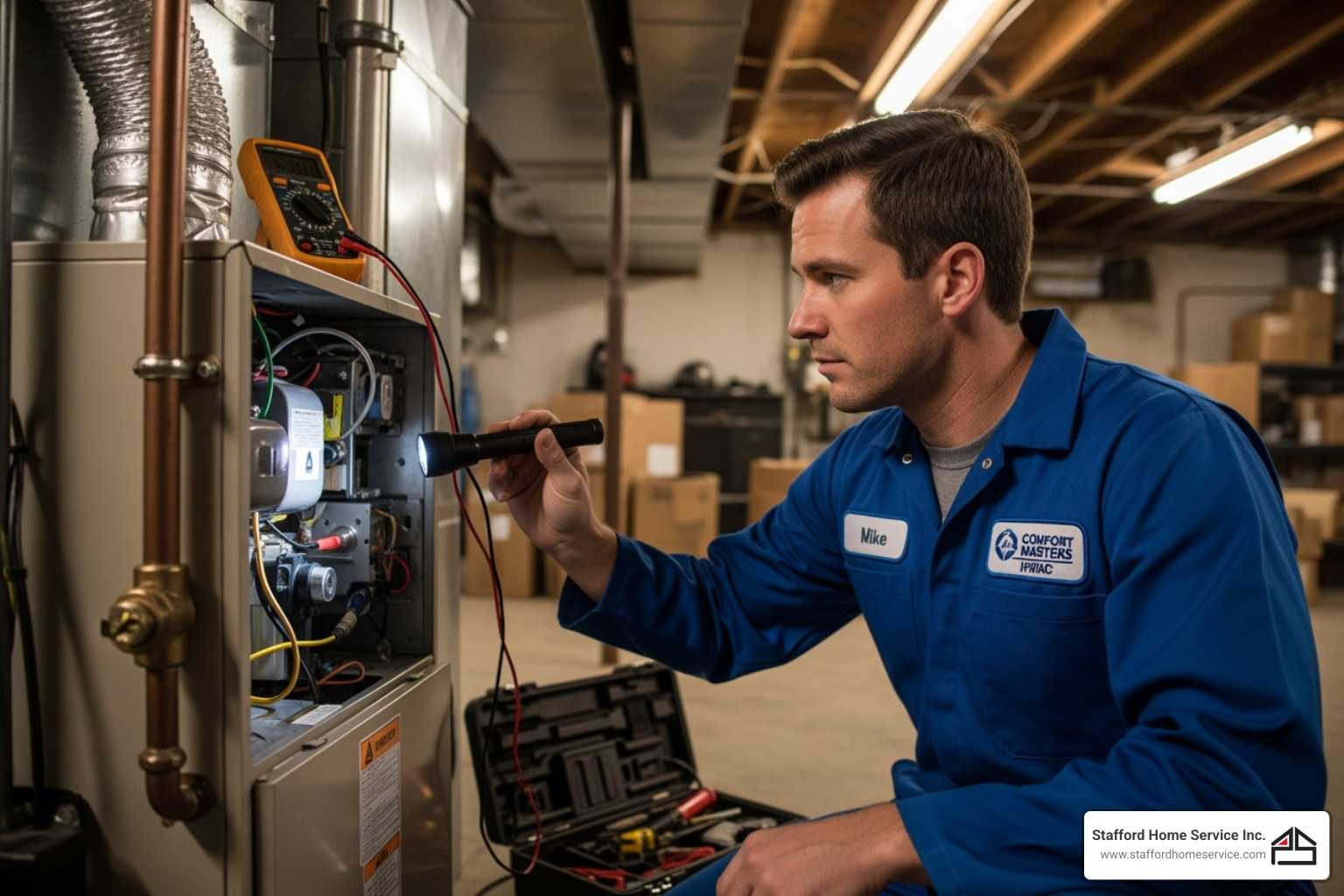The Unpleasant Surprise of Cold Air from Your Heater
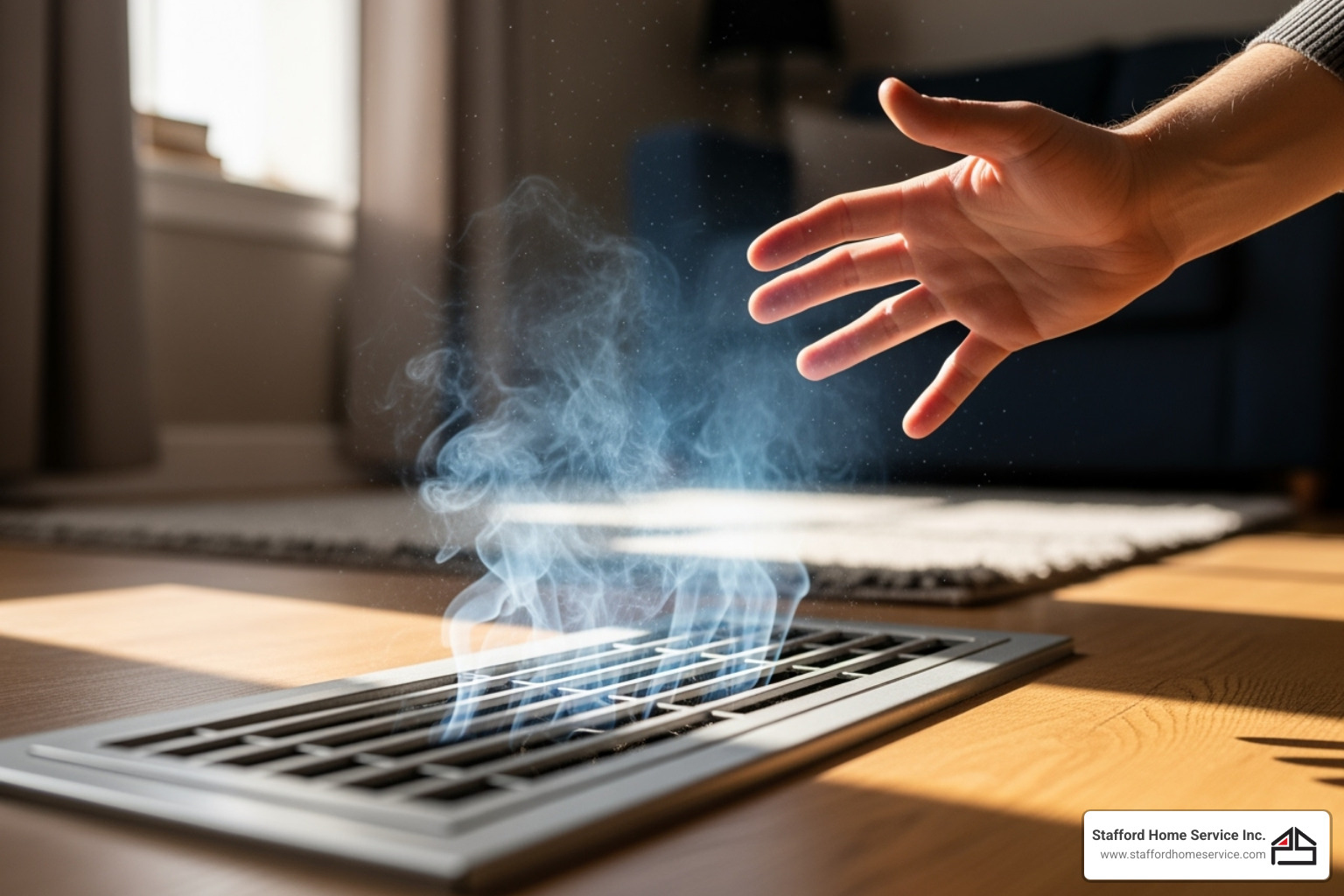
There’s nothing worse than turning on your heating system on a chilly day, expecting warmth, and instead being greeted by a blast of cold air. If your heater blowing cold air, it’s a frustrating problem that leaves your home feeling uncomfortable. But don’t worry, many common issues can cause this, and often they’re easier to fix than you might think.
When your heater isn’t doing its job, it’s important to understand why. Here are the most common reasons your heater might be blowing cold air:
- Incorrect Thermostat Settings: Your thermostat might be set to the wrong mode or fan setting.
- Clogged Air Filter: A dirty filter can block airflow, causing your system to overheat and shut down.
- Pilot Light is Out: For older furnaces, a pilot light that’s gone out means no flame to produce heat.
- Blocked Vents: Closed or obstructed vents can trap heat and cause your system to cycle incorrectly.
- Clogged Condensate Line: This can trigger safety switches, preventing your furnace from heating.
We’ll walk you through these issues and more, helping you get your home back to cozy comfort.
Heater blowing cold further reading:
First Steps: Simple Checks You Can Do in Minutes
Before you panic or call for professional help, there are several quick diagnostics you can perform to figure out why your heater blowing cold air. These simple checks take just minutes and often solve the problem without any tools or expertise required.
Start with your thermostat – it’s the most common culprit and the easiest fix. We’ve all been there: accidentally bumping a setting or forgetting to switch from “Cool” to “Heat” when the seasons change. It happens to the best of us!
The fan setting is particularly important here. Your thermostat has two fan options: “Auto” and “On.” When set to “On,” the fan runs constantly, even when your heating system isn’t actively producing heat. This means you’ll get unheated air blowing through your vents between heating cycles, making you think your heater blowing cold when it’s actually just circulating room-temperature air. Always keep your fan setting on “Auto” so it only runs when your system is actively heating.
Programmable thermostats can be tricky too. Check if your schedule got thrown off by Daylight Savings Time or if someone accidentally programmed it to run in energy-saving mode when you want it toasty. Sometimes these schedules have a mind of their own.
Don’t forget about dead batteries in your thermostat. When batteries run low, your thermostat might not communicate properly with your heating system, leading to erratic behavior or complete shutdown. It’s a simple fix that costs just a few dollars.
Here’s your thermostat checklist to run through quickly:
- Is the system mode set to “Heat”?
- Is the fan mode set to “Auto”?
- Is the desired temperature set higher than the current room temperature?
- Are the batteries fresh?
- Are there any programmed schedule overrides that might be active?
Now, here’s something that might surprise you: sometimes cold air is completely normal. Many modern furnaces have a built-in “blower delay” function that allows the heat exchanger to warm up before the fan starts circulating air. This prevents that initial blast of cold air from hitting you. Think of it like waiting for your coffee maker to brew – your furnace needs a moment to get hot before it can share the warmth.
If your heater blowing cold for just a minute or two before warming up, this delay function is probably doing its job perfectly.
Check your vents and air grilles throughout your home. Your heating system is like the lungs of your house – it needs clear airways to breathe properly. Furniture pushed against supply vents, rugs covering return air grilles, or even dust buildup can restrict airflow. When air can’t move freely, your system works harder, becomes less efficient, and may even overheat and shut down as a safety measure.
Walk around your home and make sure all vents are open and unobstructed. You’d be amazed how often a strategically placed couch or holiday decorations can block airflow without anyone noticing.
For more detailed troubleshooting steps, check out our comprehensive guide on Diagnose and Fix Heater Problems.
Common Causes for a Heater Blowing Cold
When the simple fixes don’t solve your cold air problem, it’s time to look deeper. Most heater blowing cold situations stem from three main areas: airflow problems, ignition issues, or safety systems doing their job. While these causes require more detective work, understanding them helps you know when you can tackle the problem yourself and when it’s time to call in the pros.
Airflow and Filtration: A Top Reason Your Heater is Blowing Cold
Think of your heating system like it needs to breathe. When that breathing gets restricted, everything goes wrong fast. The most common culprit? That innocent-looking air filter you might have forgotten about.
A clogged air filter creates a domino effect that often ends with your heater blowing cold air. Here’s what happens: as the filter gets dirtier, it blocks more and more airflow into your furnace. Your poor furnace starts working harder, getting hotter and hotter, until finally a safety device called the high-limit switch says “enough!” and shuts down the burners to prevent damage.
But here’s the frustrating part – the blower fan keeps running, pushing unheated air through your vents. You’re left wondering why your heater seems to be working (you can hear it running) but only blowing cold air.
The solution is simple but important: check and replace your filter every 1-3 months, especially during heavy heating season. A clean filter isn’t just about air quality – it’s essential for your system to work properly.
Sometimes the problem isn’t the filter but other airflow issues. Your furnace has a dirty flame sensor that can get covered in carbon buildup over time. This little sensor’s job is to detect whether the burner is actually lit. When it’s dirty, it might think there’s no flame even when there is, so it shuts off the gas supply as a safety measure. The result? Your heater blowing cold air while the fan keeps running.
If you have a heat pump instead of a furnace, check your outdoor condenser unit. Leaves, debris, snow, or ice can block the airflow your heat pump needs to extract heat from outside air. When it can’t breathe properly, it struggles to warm your home effectively.
For more insights into these common problems, take a look at our guide on Furnace Repair for Problems Owners Face.
Ignition and Fuel Supply: Another Cause for a Heater Blowing Cold
No spark, no heat – it’s that simple. Your heating system needs both an ignition source and fuel to create the warmth you’re expecting.
If you have an older gas furnace (usually from before the 1990s), it probably uses a pilot light – a small flame that stays lit to ignite the main burners when needed. When this little flame goes out due to a draft, debris, or a faulty thermocouple, your furnace can’t light the main burners. You might hear the system trying to work, but you’ll only get cold air.
Relighting a pilot light involves following your furnace manual’s specific instructions, usually with a reset button and careful use of a match. Always prioritize safety when dealing with gas and open flames – when in doubt, call a professional.
Modern furnaces use electronic ignition systems instead – either hot surface ignitors or spark ignitors. When these components fail, the furnace simply can’t light the gas, leaving you with a heater blowing cold air. These electronic systems are generally more reliable than pilot lights, but when they break, they usually need professional replacement.
Sometimes the problem isn’t ignition but fuel supply. Your furnace needs a steady flow of natural gas or propane to operate. If someone accidentally turned off the gas supply valve to your furnace, or if there are gas line issues, the burners won’t get the fuel they need. For any suspected gas problems, contact a professional immediately – this isn’t a DIY situation.
Drainage and Safety Switches
Modern heating systems are smart – they have built-in safety features that will shut things down when something’s not right. While this protects your home and family, it can also leave you scratching your head about why your heater blowing cold air.
High-efficiency furnaces create water as they work, and this condensate needs somewhere to go. It typically drains through a PVC pipe, but when that condensate drain line gets clogged with algae, dirt, or debris, the water backs up. Many furnaces have a safety float switch that detects this backup and immediately shuts down the system to prevent water damage.
Overheating from any cause – whether it’s a dirty filter, blocked vents, or dirty coils – triggers safety switches that shut down the heating elements while letting the fan continue running. This protects your furnace from damage but leaves you with cold air circulation.
The limit switch is another safety hero that can cause confusion. This component monitors the temperature inside your furnace and tells the blower when to turn on and off. When it malfunctions, it might tell the fan to run when the furnace isn’t hot, or prevent the burners from firing up entirely.
These safety systems are doing their job, but the result is the same: your heater blowing cold air when you need warmth most. Understanding these causes helps you communicate better with HVAC professionals and sometimes identify simple solutions.
You can learn more about these and other common issues on our Heater Not Working page.
Understanding Your System: Furnace vs. Heat Pump Issues
When your heater blowing cold air, the first step in solving the problem is understanding what type of heating system you have. Different systems work in completely different ways, which means they also fail in different ways.
How a furnace works: Think of your furnace as a controlled campfire in a metal box. It burns natural gas, propane, or oil to create heat, then transfers that heat to air through a component called a heat exchanger. A blower fan then pushes this warmed air through your ductwork and into your rooms. The key thing to remember is that the combustion process stays completely separate from the air you breathe.
How a heat pump works: A heat pump is more like a magician than a campfire. Instead of creating heat by burning fuel, it moves heat from one place to another using refrigerant and a clever device called a reversing valve. Even when it’s cold outside, there’s still heat energy in the air – your heat pump extracts that energy and brings it inside. It’s essentially an air conditioner running in reverse.
| Issue Type | Furnace Specific Causes | Heat Pump Specific Causes |
|---|---|---|
| Airflow | Clogged filter, blocked vents, dirty flame sensor | Clogged filter, blocked vents, blocked outdoor unit |
| Ignition/Fuel | Pilot light out, electronic ignition failure, gas supply issues | (Not applicable – no combustion) |
| Safety/Drainage | Clogged condensate line, faulty limit switch, overheating | Clogged condensate line, faulty limit switch, overheating |
| System-Specific Parts | Cracked heat exchanger | Defrost mode, faulty reversing valve, low refrigerant levels |
Understanding these differences helps explain why some troubleshooting advice might not apply to your specific system. You can find more detailed discussions on heat pump issues in forums like this heat pump troubleshooting discussion.
Furnace-Specific Problems
Beyond the common issues we’ve already covered, furnaces have some unique problems that can leave your heater blowing cold air.
Cracked heat exchanger is probably the most serious furnace problem you can face. The heat exchanger is like the dividing wall between the combustion process and your home’s air. Over time, the constant heating and cooling can cause metal fatigue, leading to cracks. When this happens, dangerous combustion gases – including deadly carbon monoxide – can mix with your indoor air.
Your furnace’s safety systems will often detect this problem and shut down the heating elements as a protective measure. This leaves you with cold air, but more importantly, it’s protecting your family from a potentially life-threatening situation. A cracked heat exchanger almost always requires professional inspection and often complete replacement.
Combustion process issues can also cause problems. If there’s not enough air for proper combustion, or if the venting system is blocked, your furnace might struggle to maintain a proper flame. Modern furnaces have sensors that detect these conditions and will shut down the system rather than risk unsafe operation.
Heat Pump-Specific Problems
Heat pumps are wonderfully efficient, but they have their own unique quirks that can result in your heater blowing cold air.
Defrost mode is actually a normal function, but it can be alarming if you don’t know what’s happening. When outdoor temperatures hover around freezing, moisture in the air can freeze on your heat pump’s outdoor coil. To keep working efficiently, your system will periodically reverse itself to melt this ice away.
During defrost mode, your heat pump temporarily becomes an air conditioner, sending warm refrigerant outside to melt the ice. This means cool air will blow from your vents for a few minutes. If this happens occasionally on cold, humid days, it’s perfectly normal. If it’s happening constantly or for long periods, that’s when you need professional help.
Iced-over outdoor unit can be a bigger problem than normal defrost cycles. If your outdoor unit is completely encased in ice, or if snow and debris are blocking airflow, your heat pump can’t extract heat effectively. This forces it to work much harder and may result in lukewarm or cold air from your vents.
Faulty reversing valve is like having a stuck gear shift in your car. This valve is what tells your heat pump whether to heat or cool your home. If it gets stuck in the cooling position, your system will keep trying to cool your house even when you want heat. The result? Your heater blowing cold air no matter what you do with the thermostat.
Low refrigerant levels affect heat pumps the same way low blood affects your body – everything just stops working properly. Refrigerant is what carries heat from outside to inside your home. If there’s a leak, your heat pump loses its ability to transfer heat effectively, leaving you with cold air and higher energy bills.
Unlike a car where you might just “top off” fluids, refrigerant leaks require professional attention. The refrigerant needs to be recovered, the leak needs to be found and repaired, and then the system needs to be properly recharged with the exact amount of refrigerant your system requires.
When to Call a Professional for Your Heater Problem
While some heater blowing cold issues can be resolved with DIY checks, many problems require the expertise of a qualified HVAC professional. Knowing when to call for help is crucial for both your comfort and safety – and honestly, it can save you from turning a small problem into an expensive disaster.
Safety concerns should always be your top priority. If you suspect gas line issues, smell gas, or think you might have a cracked heat exchanger, don’t play hero. These situations can be genuinely dangerous. Gas leaks can lead to explosions, and a cracked heat exchanger can release carbon monoxide – a silent killer that you can’t see or smell.
Complex repairs involving your furnace’s internal components often require specialized tools and knowledge. Changing a filter is straightforward, but diagnosing why your flame sensor keeps getting dirty or why your limit switch keeps tripping? That’s where experience really matters.
Electrical issues beyond checking a tripped breaker should be left to professionals. Your heating system involves high-voltage components that can be hazardous if handled incorrectly. Similarly, refrigerant handling for heat pumps requires specific certifications and equipment – it’s not a weekend DIY project.
If your heater blowing cold air persists after you’ve tried the basic troubleshooting steps, it’s time to call in the experts. Sometimes the obvious fixes aren’t the real problem, and a trained eye can spot issues that aren’t immediately apparent.
Consequences of ignoring the problem can be more serious than just bundling up in extra blankets. A struggling system works harder, leading to increased energy bills that can really add up over a heating season. More importantly, small problems have a nasty habit of becoming big, expensive ones. That dirty flame sensor might seem minor now, but if it causes your furnace to cycle on and off repeatedly, it can damage other components and lead to system damage that costs much more to repair.
Signs You May Need a Repair or Replacement
Sometimes fixing your heating system is like putting a band-aid on a bigger wound. Persistent issues with your heater blowing cold air, especially if they keep coming back after repairs, often signal that your system is telling you something important.
Furnace age plays a huge role in reliability. If your system is over 15 years old, you’re entering the territory where repairs might not make financial sense anymore. Think of it like an old car – at some point, you’re spending more on fixes than the system is worth.
Frequent breakdowns are another red flag. If you’re calling for service every few months, or if your heating system has become unreliable when you need it most, it might be time to consider replacement rather than another repair.
Unusual noises or smells shouldn’t be ignored either. Your furnace shouldn’t sound like a freight train or smell like something’s burning. These symptoms often indicate worn-out components or safety issues that need immediate attention.
For more detailed guidance on replacement timing, our article on Signs That You Need a New Heating System can help you make an informed decision. Regular maintenance through our Heating Service for System Longevity program can help extend your system’s life and catch problems before they leave you shivering.
At Stafford Home Service Inc., we understand that heating problems never happen at convenient times. Our experienced team is committed to quality workmanship and complete customer satisfaction, so you can trust us to diagnose the real issue and provide honest recommendations about whether repair or replacement makes the most sense for your situation.
Frequently Asked Questions about a Heater Blowing Cold
When you’re dealing with a heater blowing cold air, you’re not alone. We hear the same concerns from homeowners throughout Minneapolis all the time. Let’s tackle the most common questions that come up during these chilly situations.
Should I turn my heater off if it’s blowing cold air?
Yes, absolutely turn your heating system off at the thermostat if it’s consistently blowing cold air. Think of it like this – you wouldn’t keep driving a car that’s making strange noises, right? The same logic applies to your heating system.
Continuing to run a malfunctioning system puts unnecessary strain on components like the blower motor, which could lead to more expensive repairs down the road. Plus, there’s really no point in circulating cold air throughout your home while you’re trying to stay warm. Turn it off, grab a cozy blanket, and start your troubleshooting process.
Why does my heater blow cold air for a minute before it gets warm?
Don’t panic if your heater blowing cold air for the first minute or two after startup – this is often completely normal! This phenomenon is called a “blower delay,” and it’s actually a thoughtful design feature in many modern furnaces.
Here’s what’s happening: your furnace is smart enough to let its heat exchanger warm up to the right temperature before the fan kicks in. This prevents you from getting that unpleasant blast of cold air that older systems used to deliver. It’s like waiting for your shower to warm up before stepping in – patience pays off with comfort.
If your system starts delivering warm air after this brief delay, you’re good to go. However, if it continues blowing cold air beyond a few minutes, then you’ve got a problem that needs attention.
Can a dirty filter really cause my heater to blow cold air?
You bet it can! This might surprise you, but a severely clogged air filter is one of the most common culprits behind a heater blowing cold air. It’s amazing how such a simple component can cause such a frustrating problem.
When your air filter gets packed with dust, pet hair, and debris, it’s like trying to breathe through a pillow – your furnace simply can’t get the airflow it needs. This restricted airflow causes your furnace to overheat, which sounds counterintuitive when you’re getting cold air, but here’s the kicker: when the internal temperature gets too high, a safety device called the “limit switch” automatically shuts off the burners to prevent damage or fire hazards.
The fan, however, keeps running and circulating unheated air throughout your home. It’s your furnace’s way of saying, “I’m overheating, so I’m going to protect myself by shutting down the heat source.” The good news? Replacing your air filter regularly is one of the easiest preventive measures you can take, and it costs just a few dollars compared to major repairs.
Restoring Your Home’s Comfort
When your heater blowing cold air disrupts your home’s comfort, it can feel overwhelming. But now you’re equipped with the knowledge to tackle the most common culprits, from simple thermostat tweaks to understanding when it’s time to call in the professionals.
Remember those simple checks we covered at the beginning? Start there every time. Make sure your thermostat is set to “Heat” and “Auto,” check that your air filter isn’t clogged, and ensure all your vents are open and unobstructed. These quick fixes solve more heating problems than you might expect.
The importance of regular maintenance can’t be overstated. Changing your air filter regularly, keeping your outdoor unit clear of debris, and scheduling annual tune-ups will prevent many of the issues that lead to cold air from your heating system. Think of it like changing the oil in your car – a little preventive care goes a long way.
Know when to call for help. While we’ve covered plenty of DIY troubleshooting, some situations require professional expertise. If you smell gas, suspect electrical issues, or your heater blowing cold air persists after trying our suggested fixes, it’s time to bring in the experts.
Safety always comes first. Never attempt repairs involving gas lines, electrical components, or refrigerant. These aren’t just comfort issues – they can be dangerous when handled incorrectly.
At Stafford Home Service Inc., we understand how frustrating it is when your heating system isn’t working properly. Our experienced team takes pride in delivering quality workmanship and complete customer satisfaction to homeowners throughout Minneapolis, Edina, Golden Valley, Minnetonka, Plymouth, St Louis Park, and across Minnesota. When your home needs reliable heating repair or maintenance, we’re here to restore your comfort quickly and safely.
Don’t let another cold day go by with an underperforming heating system. Schedule professional HVAC service in Minneapolis and get your home back to the cozy, warm environment you deserve.



